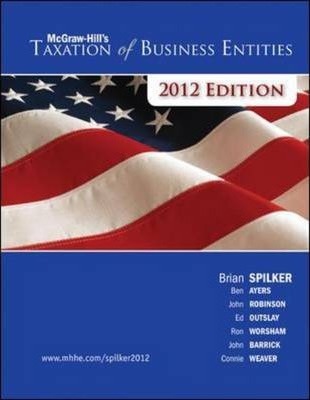
McGraw-Hill's Taxation of Business Entities 3rd Edition by Connie Weaver, Brian Spilker, Edmund Outslay, John Robinson, Ronald Worsham, Benjamin Ayers, John Barrick
Edition 3ISBN: 9780077924522
McGraw-Hill's Taxation of Business Entities 3rd Edition by Connie Weaver, Brian Spilker, Edmund Outslay, John Robinson, Ronald Worsham, Benjamin Ayers, John Barrick
Edition 3ISBN: 9780077924522 Exercise 37
Grace, James, Helen, and Charles each own equal interests in GJHC partnership, a calendar year-end, cash-method entity. On January 1 of the current year, James' basis in his partnership interest is $62,000. For the taxable year, the partnership generates $80,000 of ordinary income and $30,000 of dividend income. For the first 5 months of the year, GJHC generates $25,000 of ordinary income and no dividend income. On June 1, James sells his partnership interest to Robert for a cash payment of $70,000. The partnership has the following assets and no liabilities at the sale date:
 a. Assuming GJHC's operating agreement provides that the proration method will be used to allocate income or loss when partners' interests change during the year, what is James' basis in his partnership interest on March 1 just prior to the sale
a. Assuming GJHC's operating agreement provides that the proration method will be used to allocate income or loss when partners' interests change during the year, what is James' basis in his partnership interest on March 1 just prior to the sale
b. What is the amount and character of James' recognized gain or loss on the sale
c. If GJHC uses an interim closing of the books, what is the amount and character of James' recognized gain or loss on the sale
 a. Assuming GJHC's operating agreement provides that the proration method will be used to allocate income or loss when partners' interests change during the year, what is James' basis in his partnership interest on March 1 just prior to the sale
a. Assuming GJHC's operating agreement provides that the proration method will be used to allocate income or loss when partners' interests change during the year, what is James' basis in his partnership interest on March 1 just prior to the sale b. What is the amount and character of James' recognized gain or loss on the sale
c. If GJHC uses an interim closing of the books, what is the amount and character of James' recognized gain or loss on the sale
Explanation
In the current scenario of GJHC Partners...
McGraw-Hill's Taxation of Business Entities 3rd Edition by Connie Weaver, Brian Spilker, Edmund Outslay, John Robinson, Ronald Worsham, Benjamin Ayers, John Barrick
Why don’t you like this exercise?
Other Minimum 8 character and maximum 255 character
Character 255


